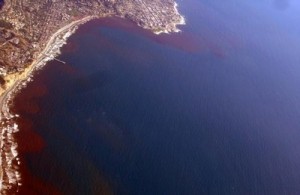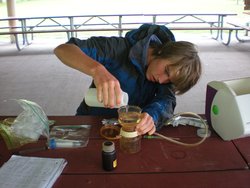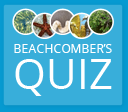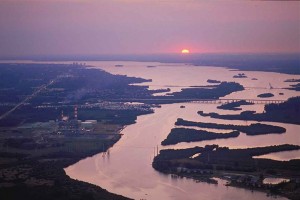- Eutrophication is the process by which a body of water becomes enriched with dissolved nutrients.
- These nutrients stimulate the growth of microscopic, free-floating plants called phytoplankton.
- Eutrophication occurs naturally, but can also be induced by human activities like fertilizer use.

Fertilizer runoff from farms is one human source of eutrophication. In this picture, rainwater is washing over fertilized fields, sweeping up fertilizer-infused soil, and washing it into rivers, and eventually out to sea.
- Eutrophication caused by humans often occurs too rapidly, as nutrients are added to the system in large quantities. This process is called nutrient loading.
- A system with too many nutrients is hypereutrophic.
- Eutrophication can be caused by point sources and non-point pollution sources. A point source is an easily identifiable source from which nutrients are added directly to the environment. For example, a sewage pipe may serve as a point-source. Non-point sources are less specific and more difficult to identify – fertilizer runoff from agricultural fields is an example of non-point source nutrient loading.

This cartoon illustrates the difference between point and non-point source pollution. Examples of point-source pollution, such as dumping from industrial facilities, are displayed on the left, while examples of non-point source pollution, such as urban runoff, are displayed on the right.
- Nitrogen and phosphorus are common causes of eutrophication.
- Scientists have associated hypereutrophic conditions with Harmful Algal Blooms, rapid increases in populations of harmful algae species.
- Like plants, algae grows well in nutrient-rich environments. Eutrophication can help harmful algae species to reproduce and grow very quickly, leading to environmental and human health problems.

Eutrophication may trigger harmful algal blooms. The nutrients delivered to the coastal ecosystem through point and non-point source pollution enhance the growth and reproduction of algae, including Karena brevis, the algae that causes Florida Red Tide.
- As bacteria break down and decompose the algae, they consume dissolved oxygen from the water.
- This decrease in dissolved oxygen concentrations can cause hypoxic or dead zones. These areas lack sufficient oxygen to support most marine life, and marine organisms either die or migrate to areas with higher dissolved oxygen concentrations.
- Harmful Algal Blooms caused by eutrophication can also block sunlight from reaching seagrass beds and other important habitats, decreasing the productivity making these ecosystems.
- To prevent the negative effects associated with eutrophication, the state of Florida works hard to monitor the nutrient concentrations in local water bodies.
- The Caloosahatchee River runs from Lake Hicpochee and Lake Okeechobee to San Carlos Bay. It is bordered by thousands of farms, and carries agricultural fertilizers and nutrient-rich livestock waste into the San Carlos estuary. Runoff from upriver agricultural sites can cause hypereutrophic conditions.
- In order to maintain the health of the fragile estuarine ecosystem in and around San Carlos Bay, scientists frequently monitor nutrient and dissolved oxygen concentrations.

A scientist monitors water for harmful algal blooms. Water sample are kept in dark containers, such as the cooler on the right, until they are processed. This scientist is filtering the water by placing it in a funnel whose bottom is lined with a carbon-fiber filter. The filter will trap tiny particles, including microalgae, which will then be extracted by placing the filter in a chemical called acetone. The acetone will extract the microalgae from the filter, and a machine called a fluorometer will measure the reaction of the acetone and sample solution when light of different wavelengths is shined on the sample. This reaction indicates the amount and type of microalgae in the sample.
Review Questions
- What is eutrophication?
- What causes eutrophication?
- Describe a negative effect that occurs when an ecosystem becomes hypereutrophic.
- What is a hypoxic zone and why is it likely to occur in hypereutrophic areas?
Glossary
Eutrophication: The process in which excessive nutrients are added to an aquatic system.
Harmful Algal Bloom (HAB): An algal bloom that has negative impacts.
Hypereutrophic: Having too many nutrients.
Hypoxic Zone (Dead Zone): Low-oxygen areas in the world’s oceans where most organisms struggle to survive.
Non-Point Source: A non-specific source of nutrient input.
Nutrient Loading: The rapid addition of nutrients to a system
Phytoplankton: Plant-like plankton
Point Source: A specific and highly identifiable source of nutrient input.

